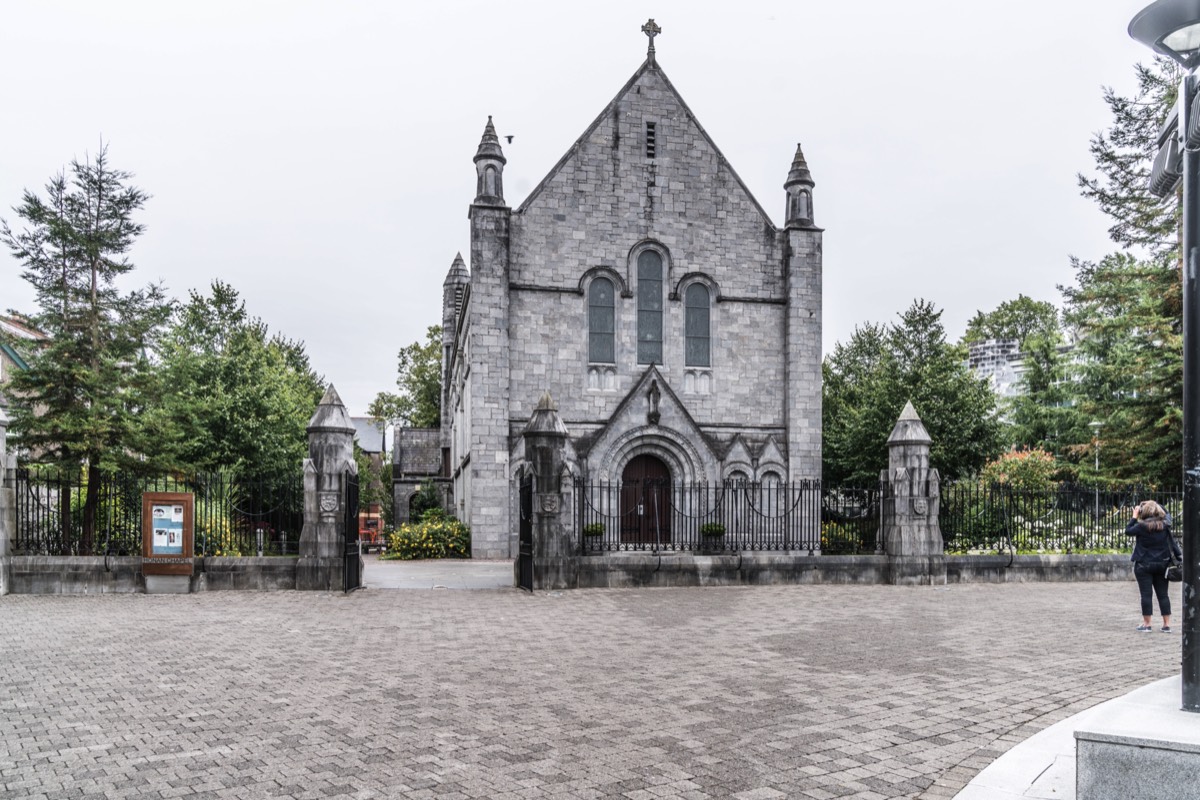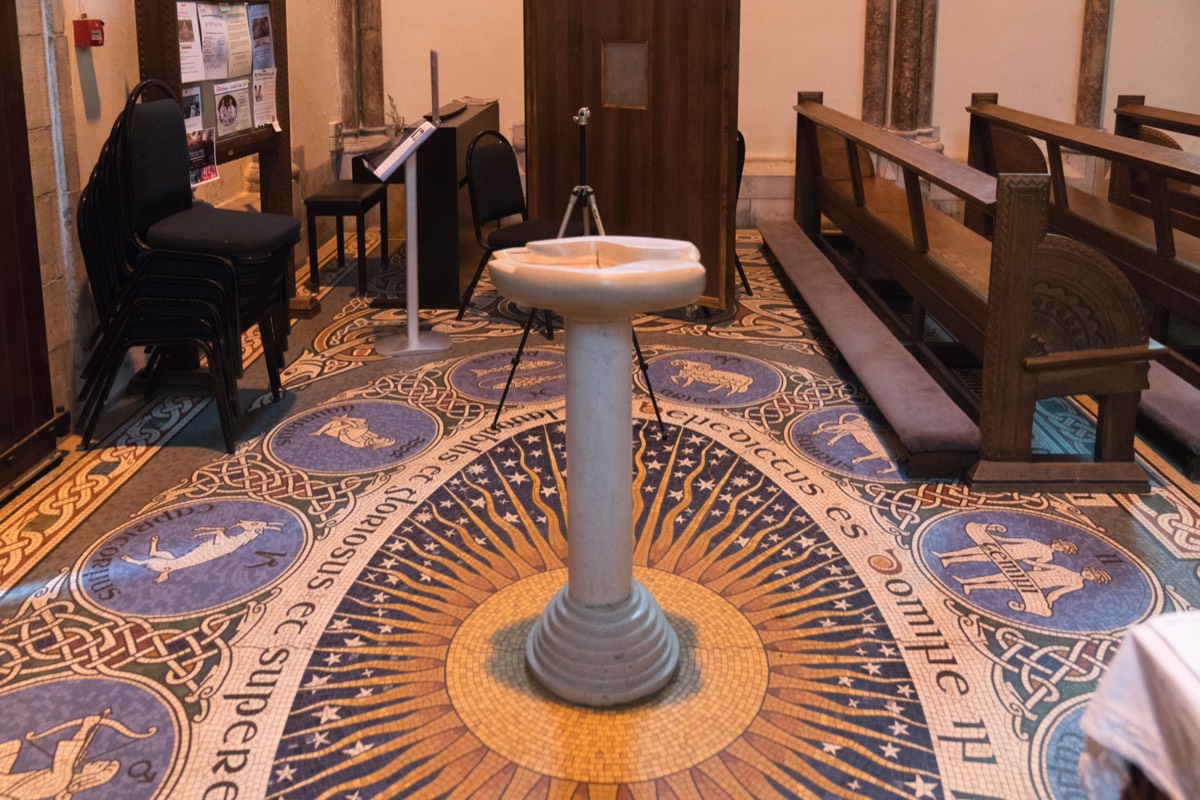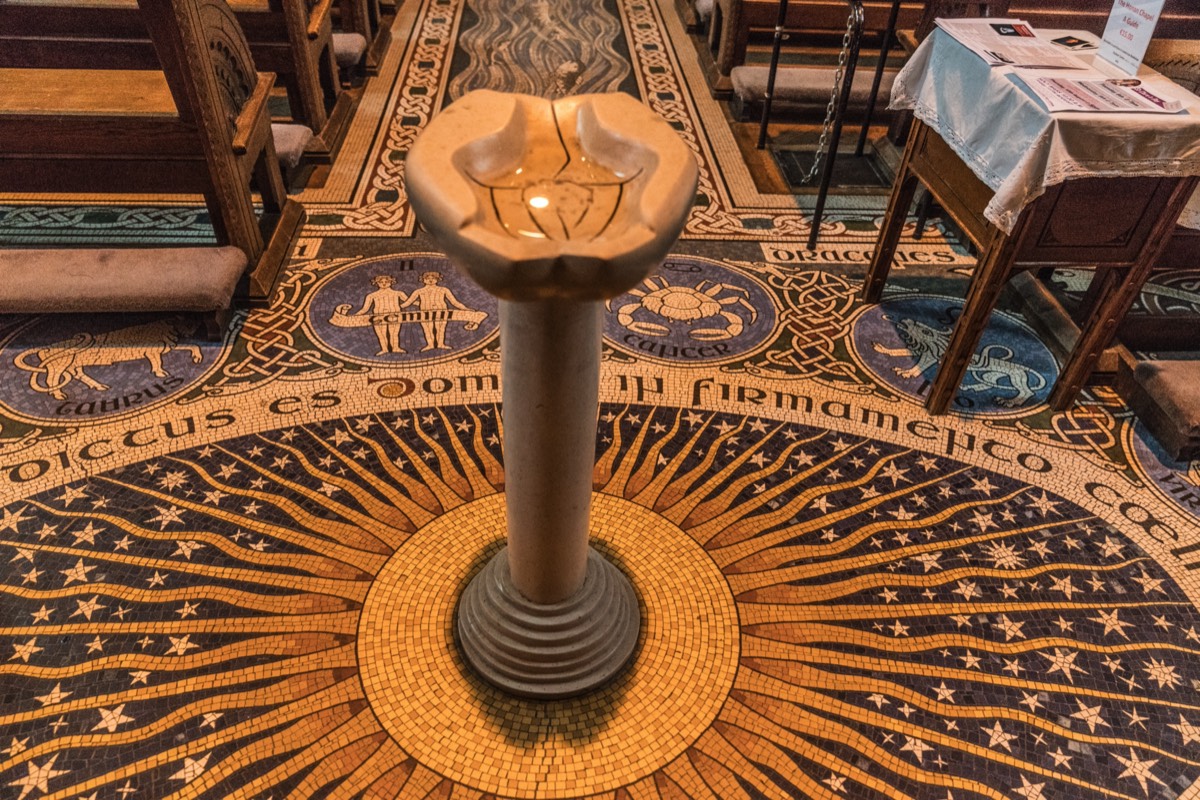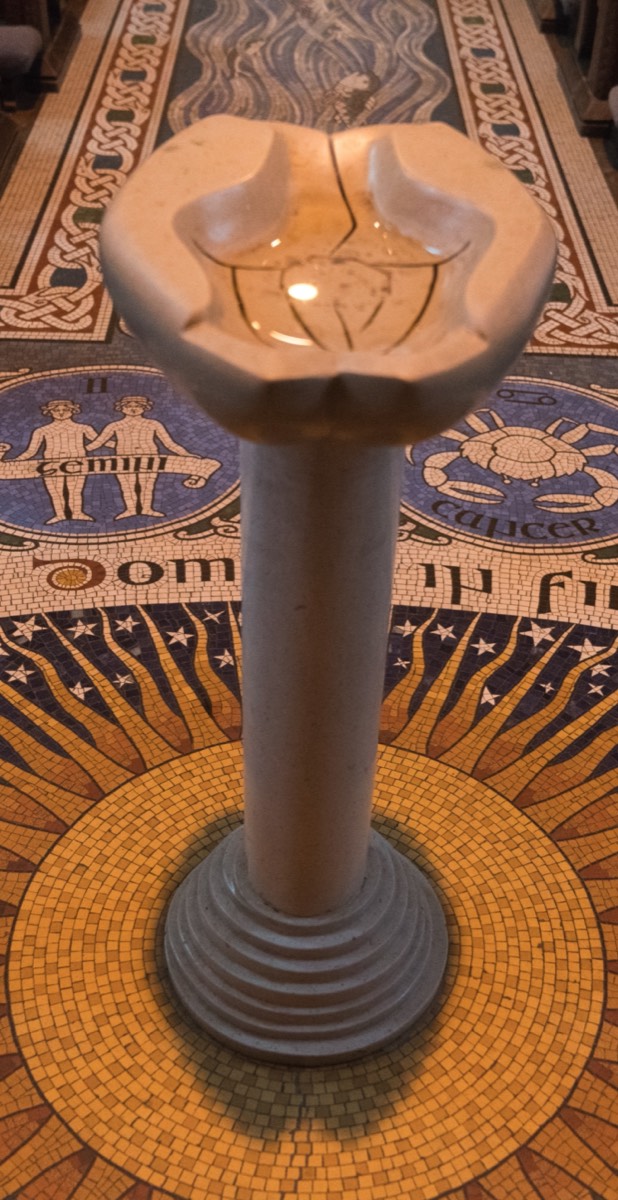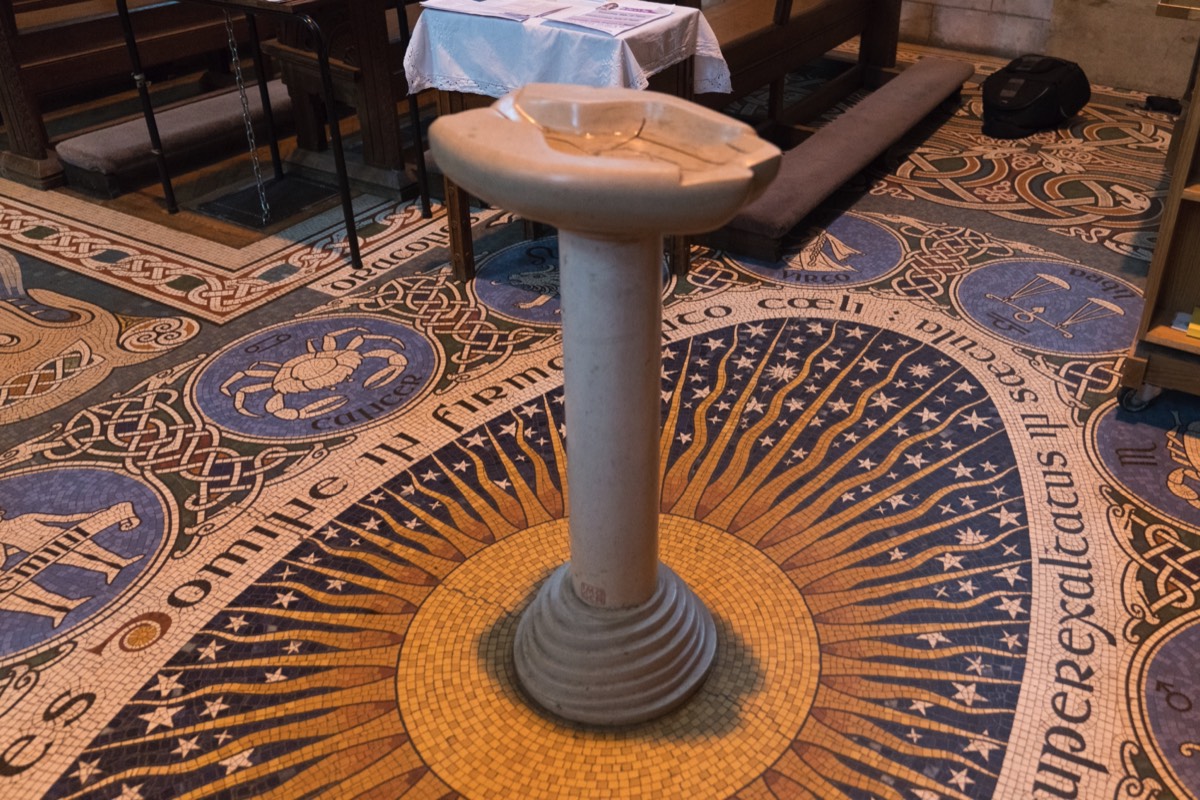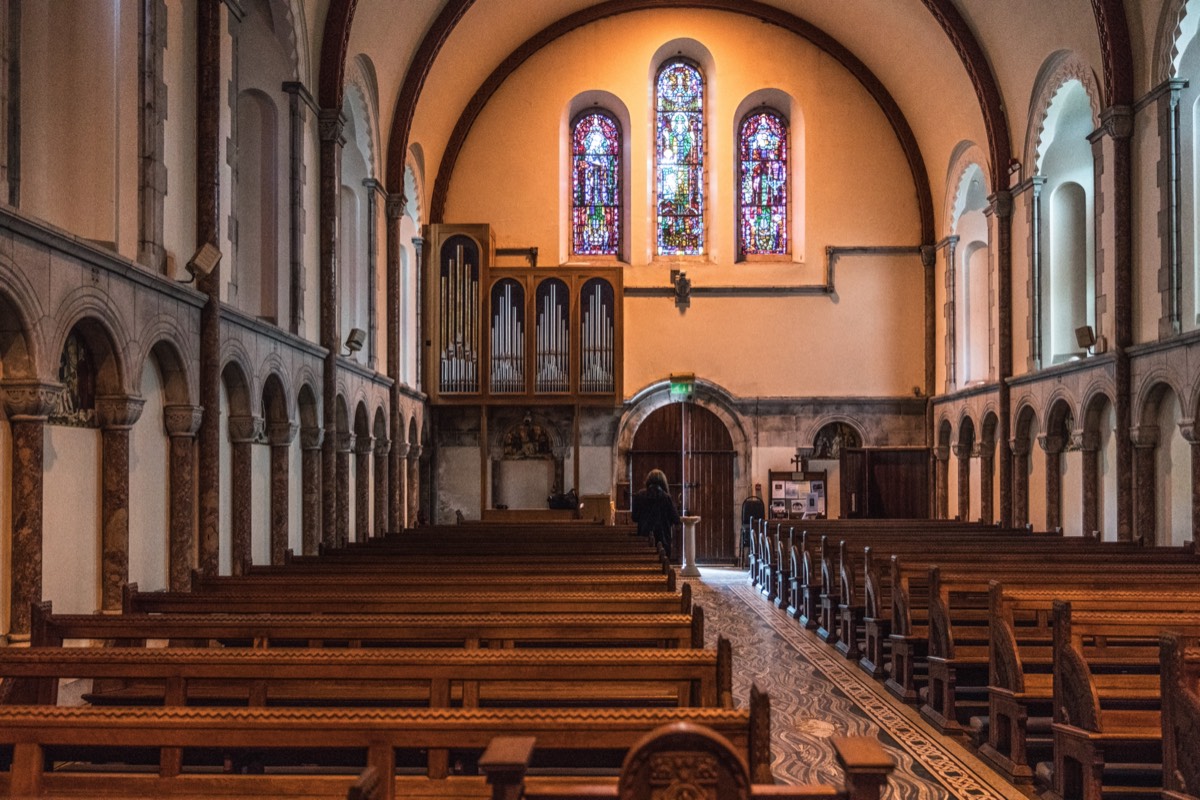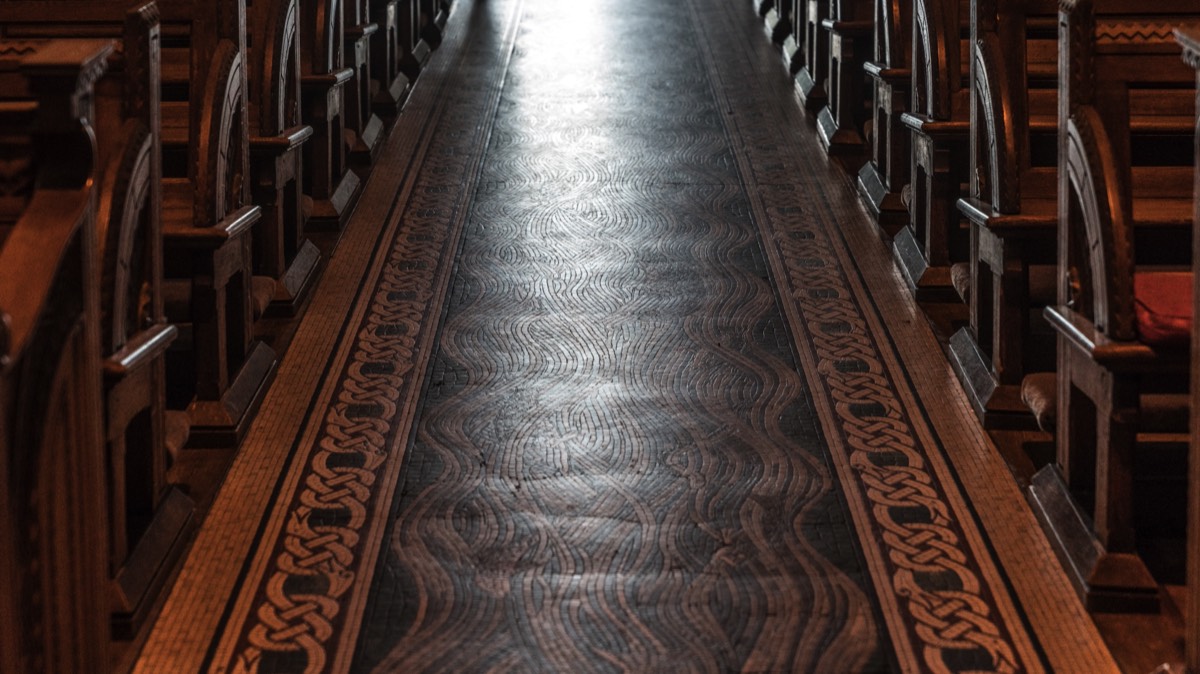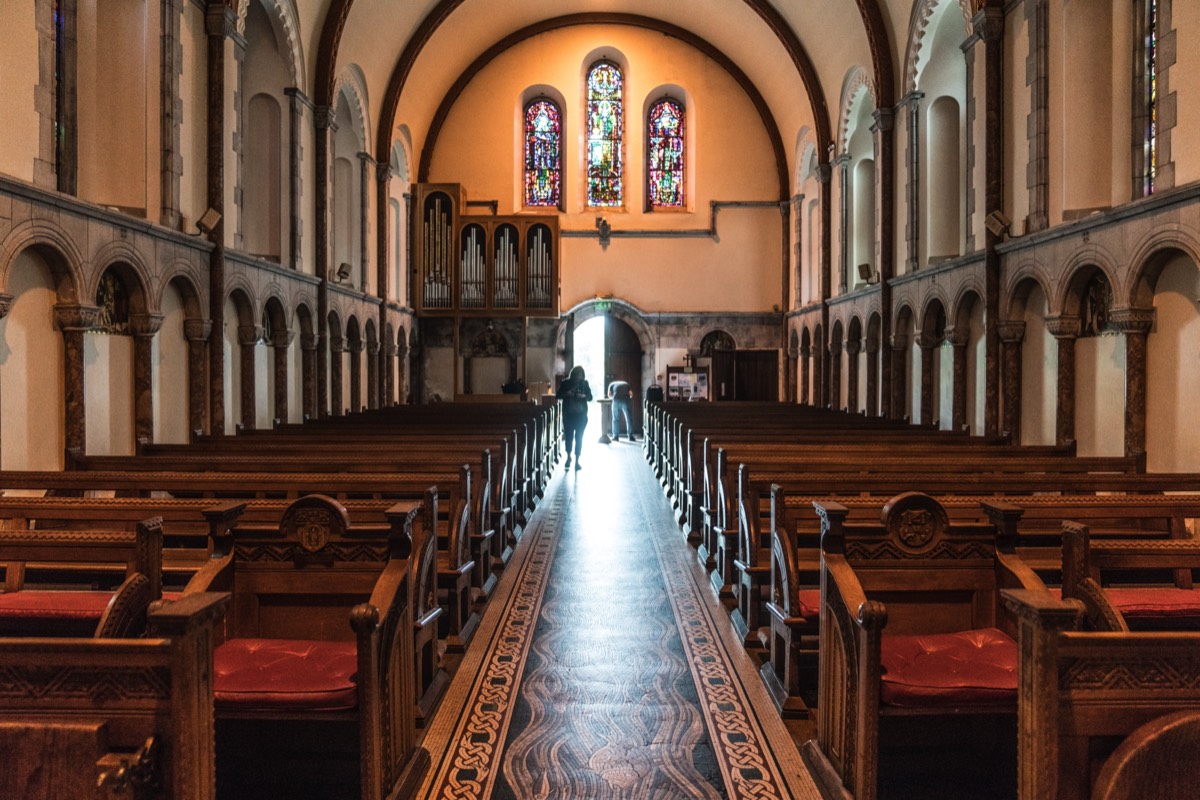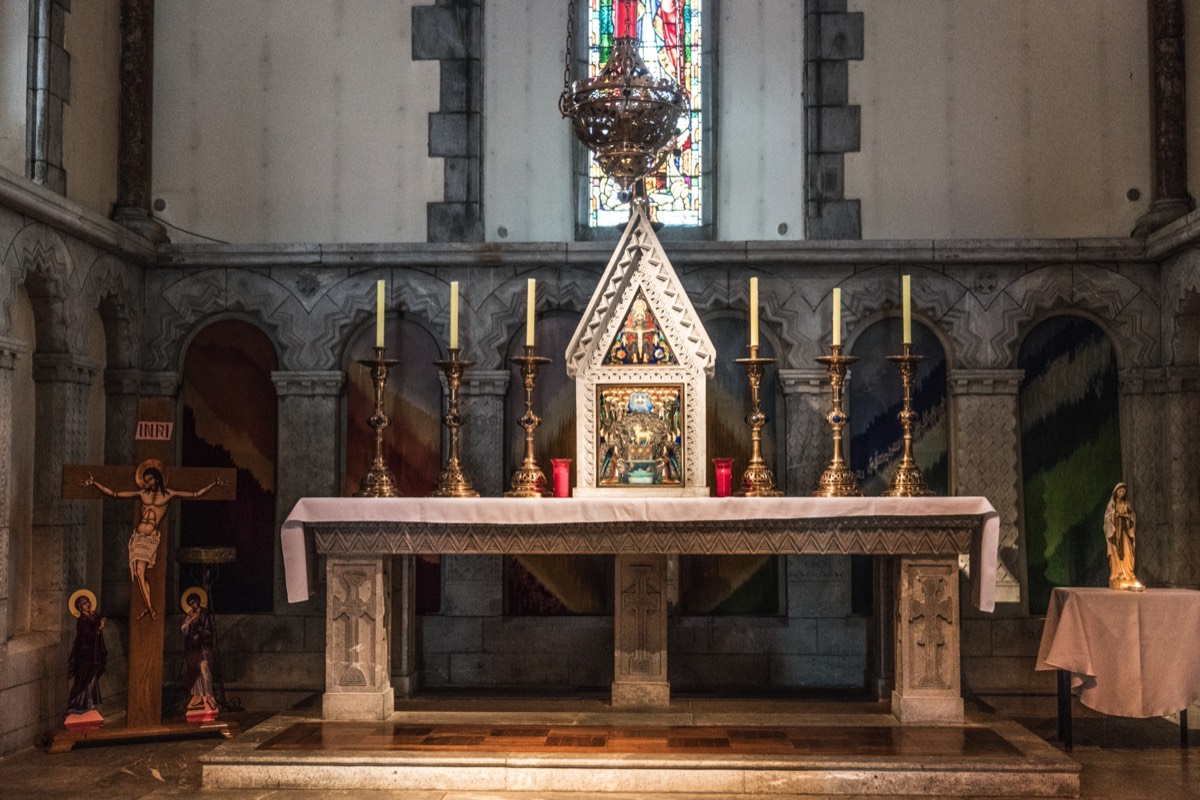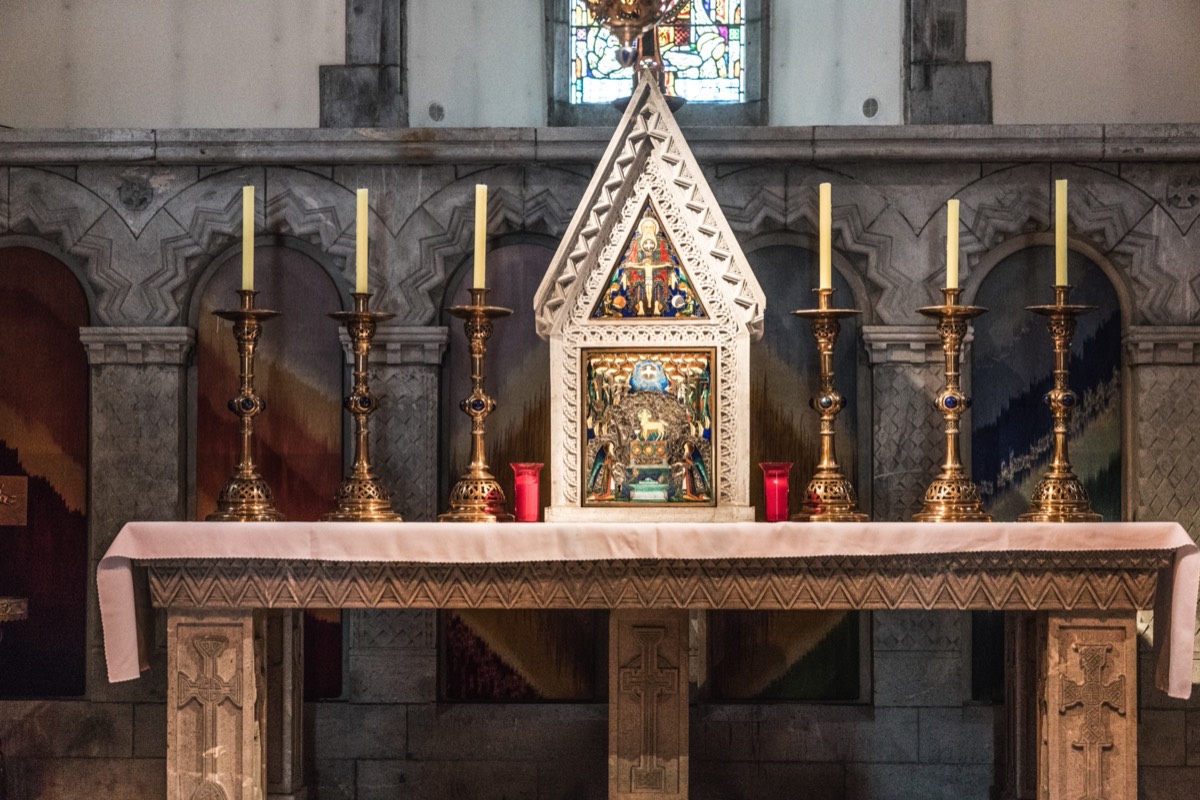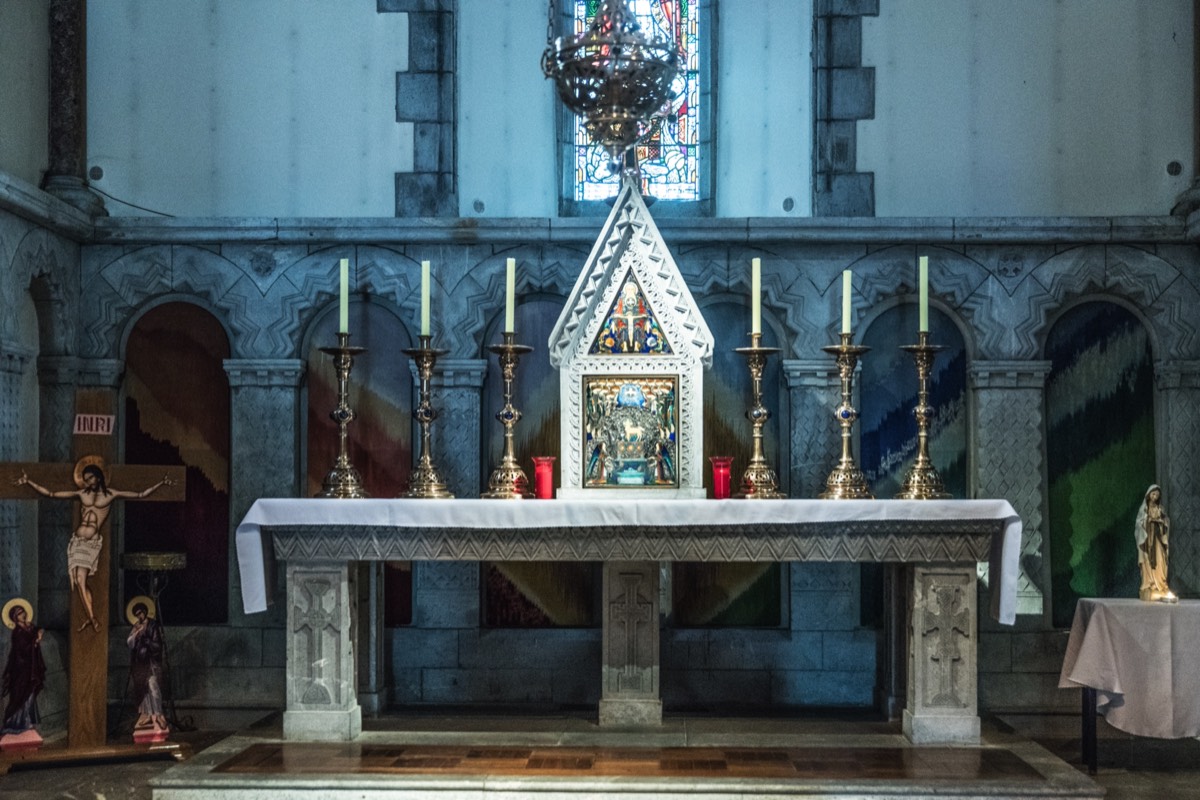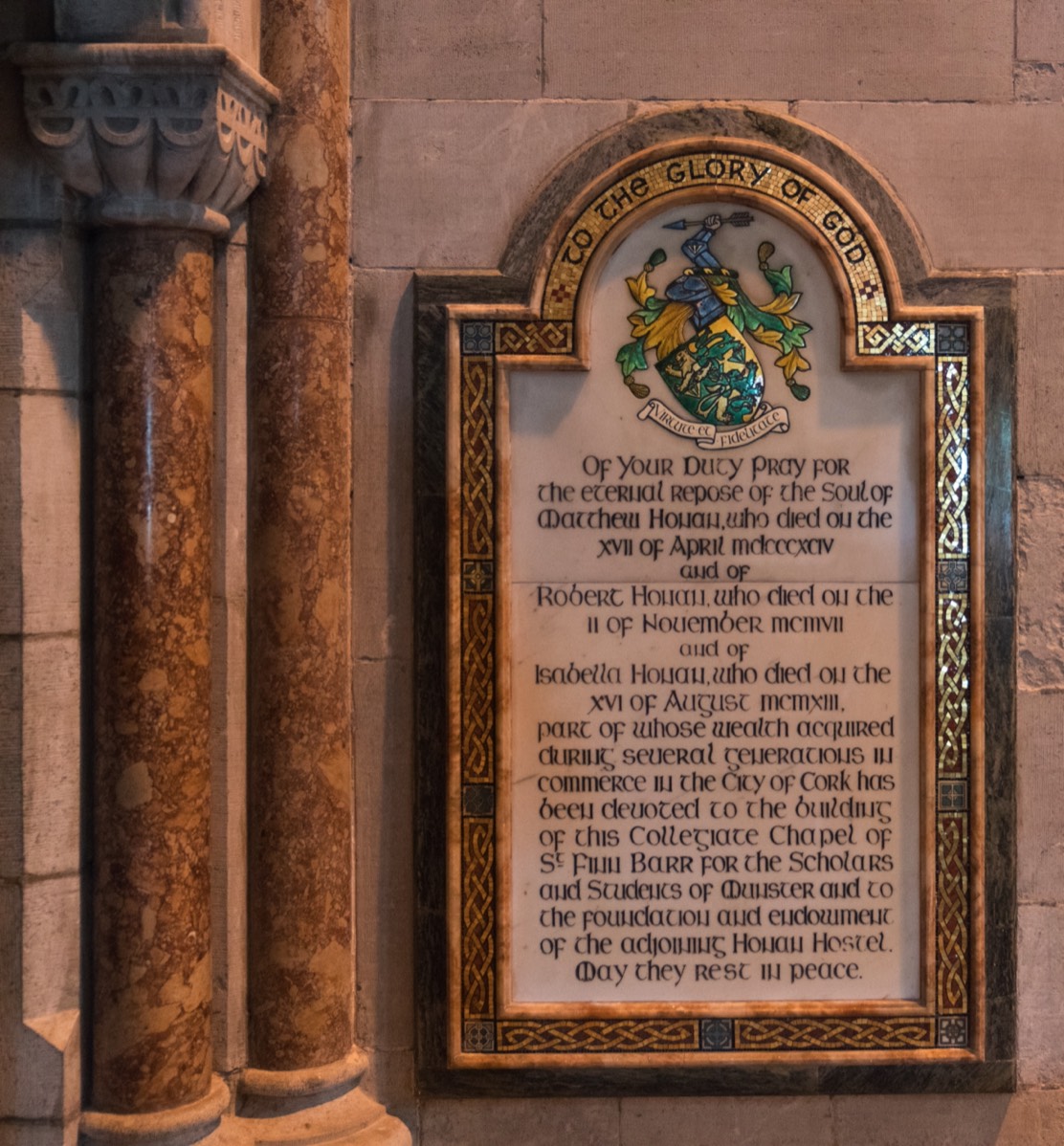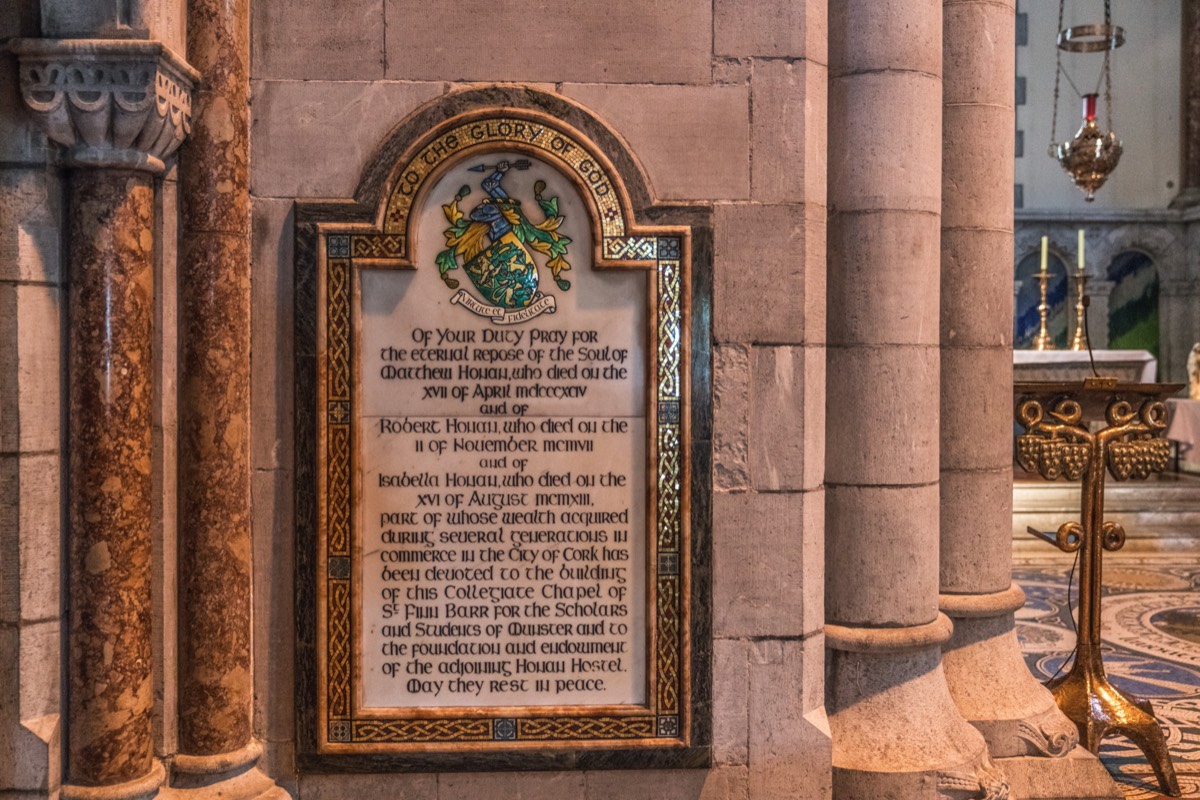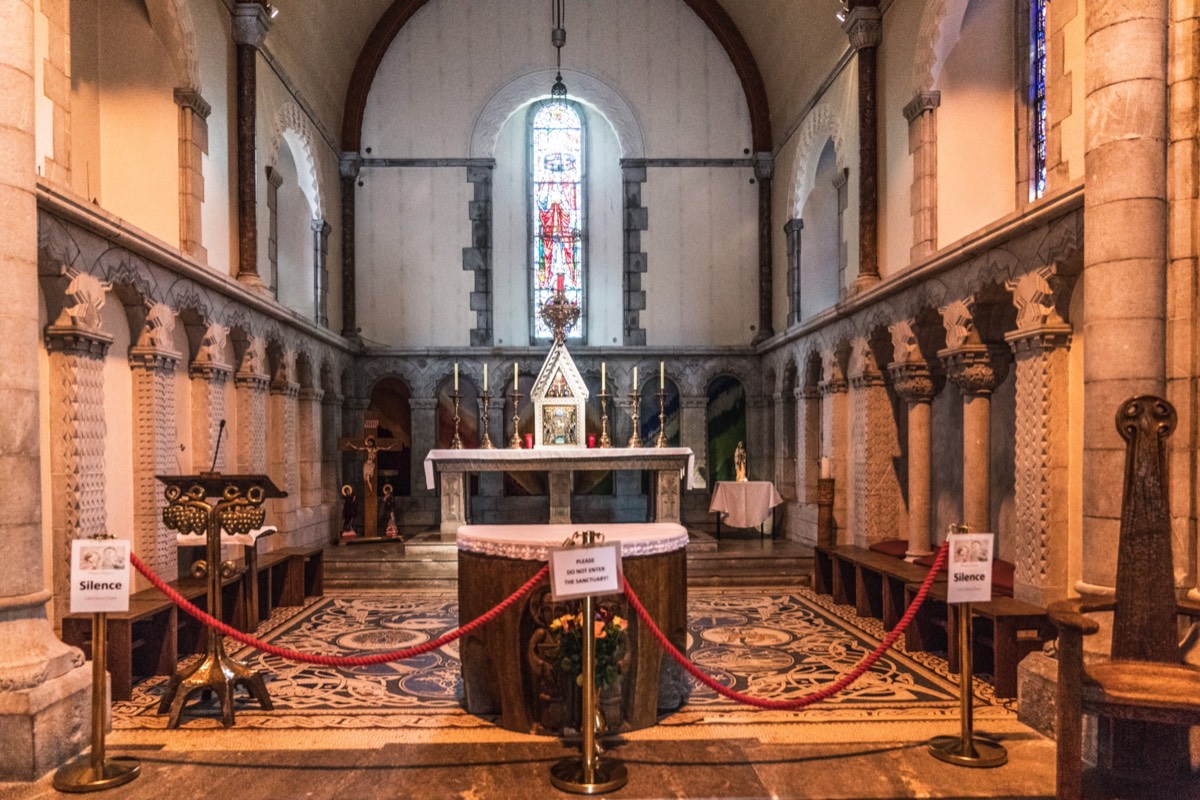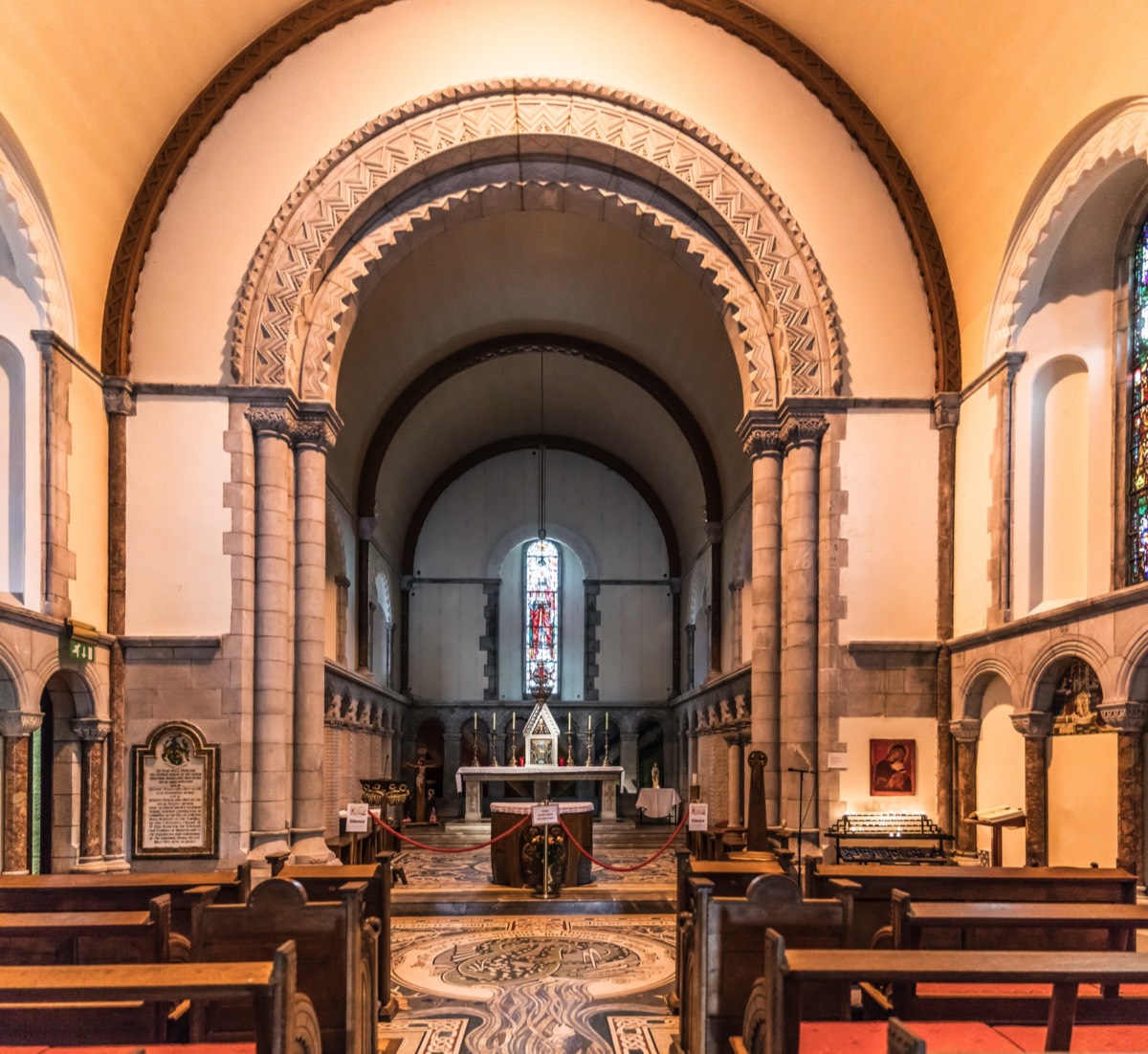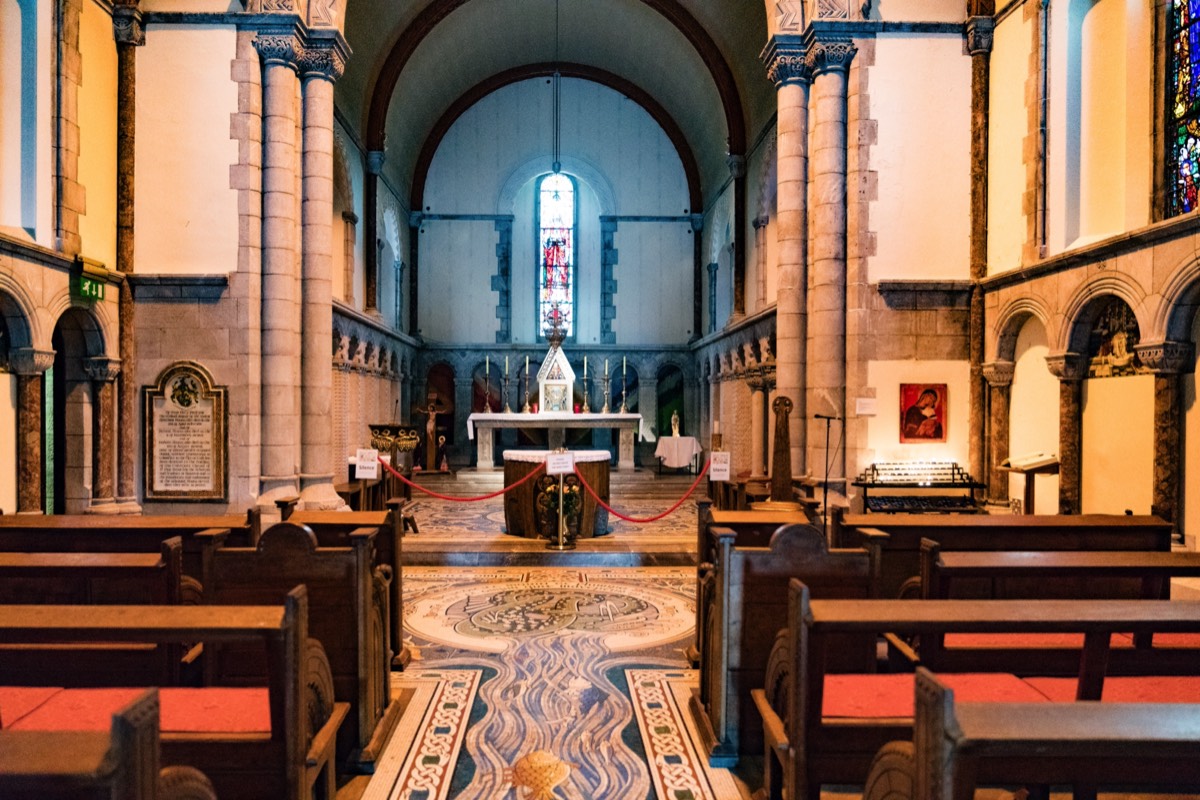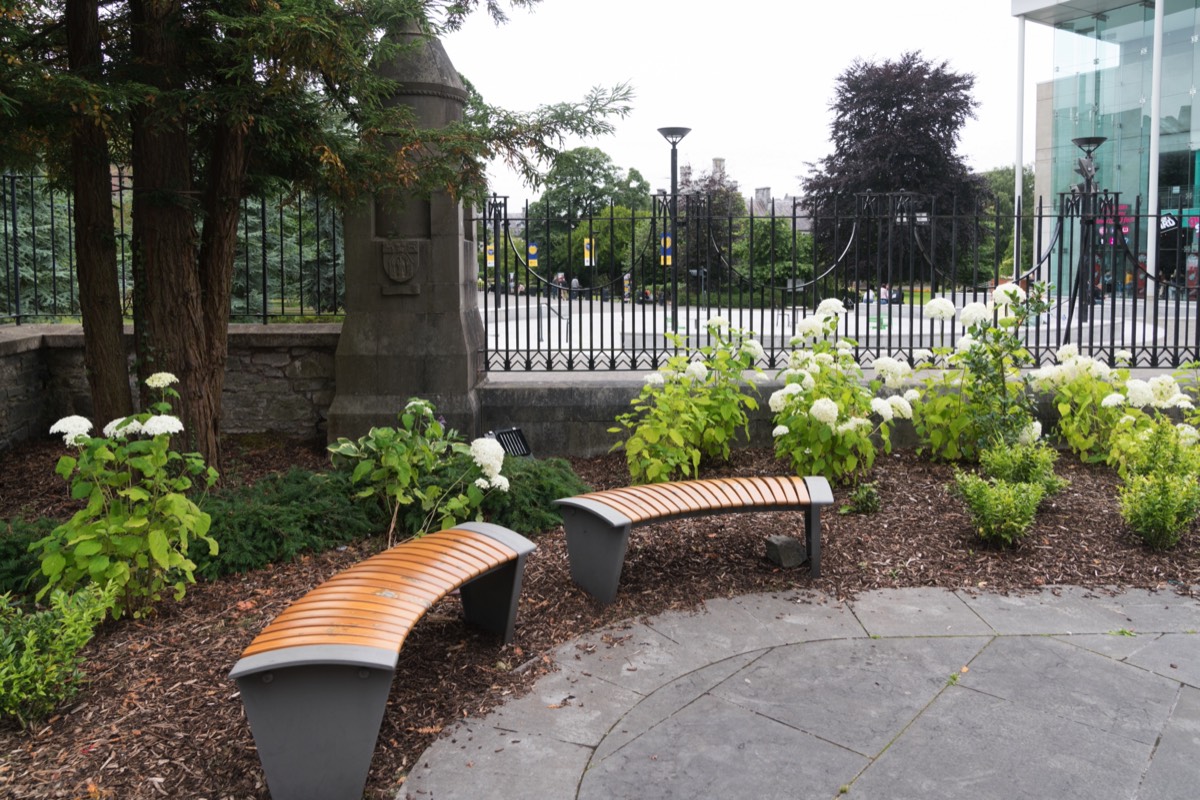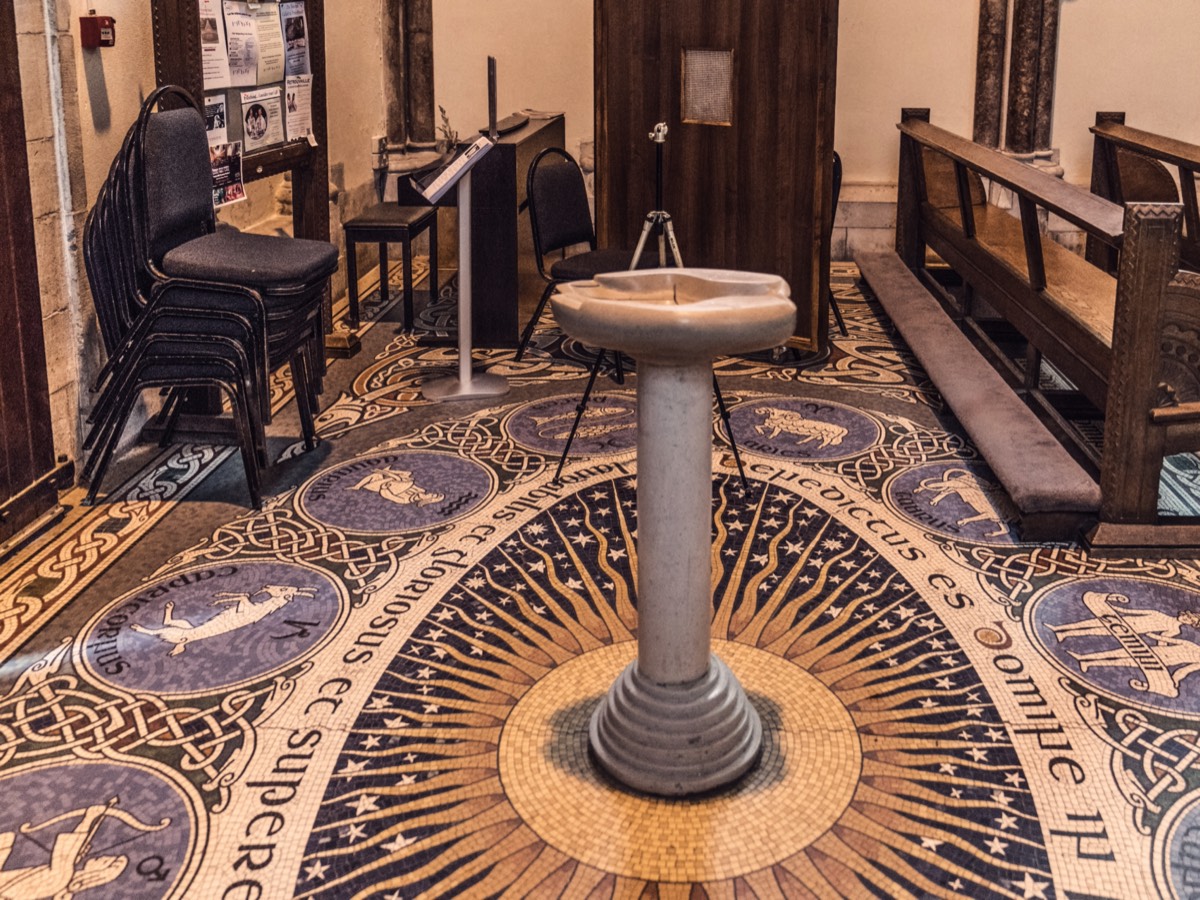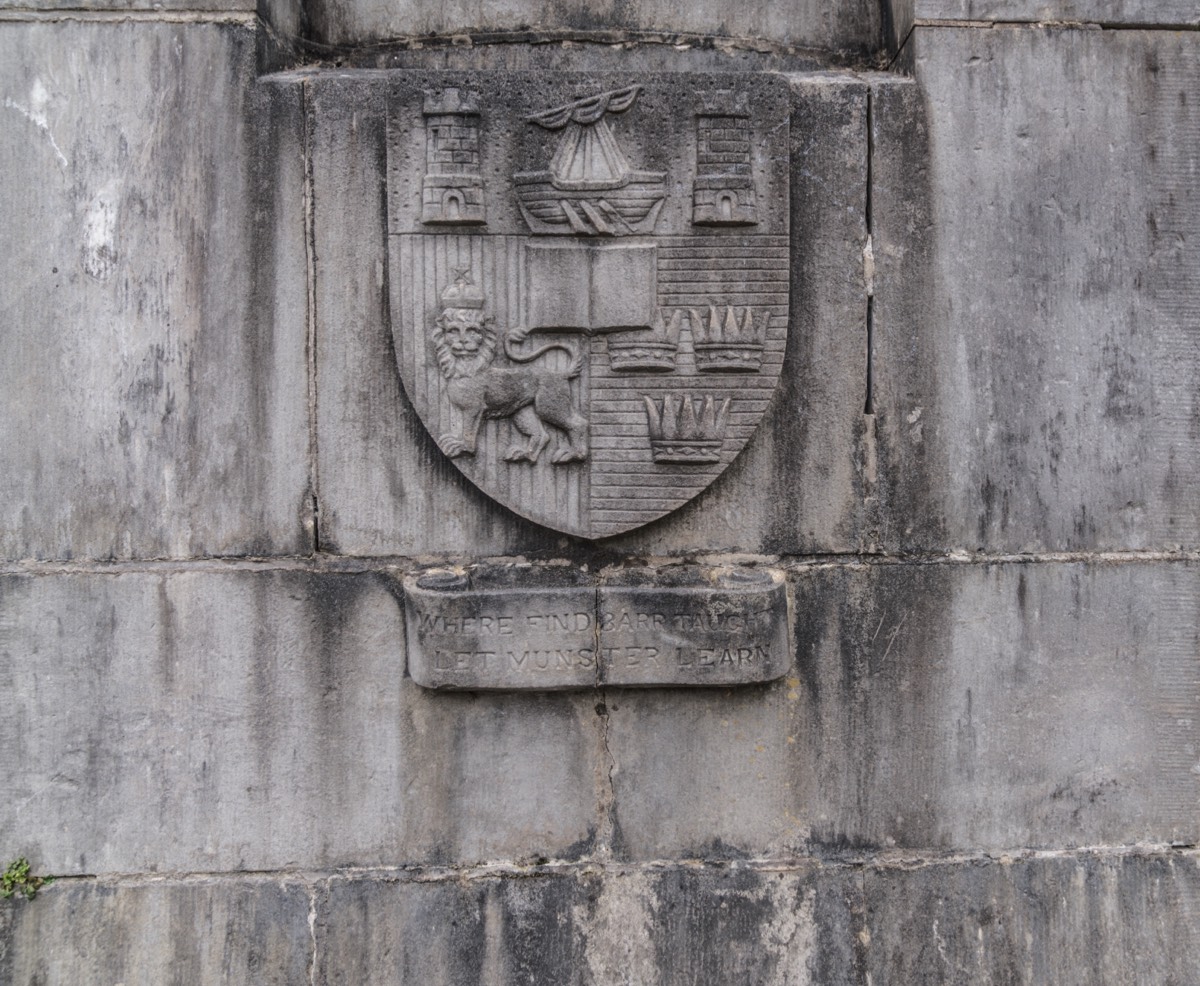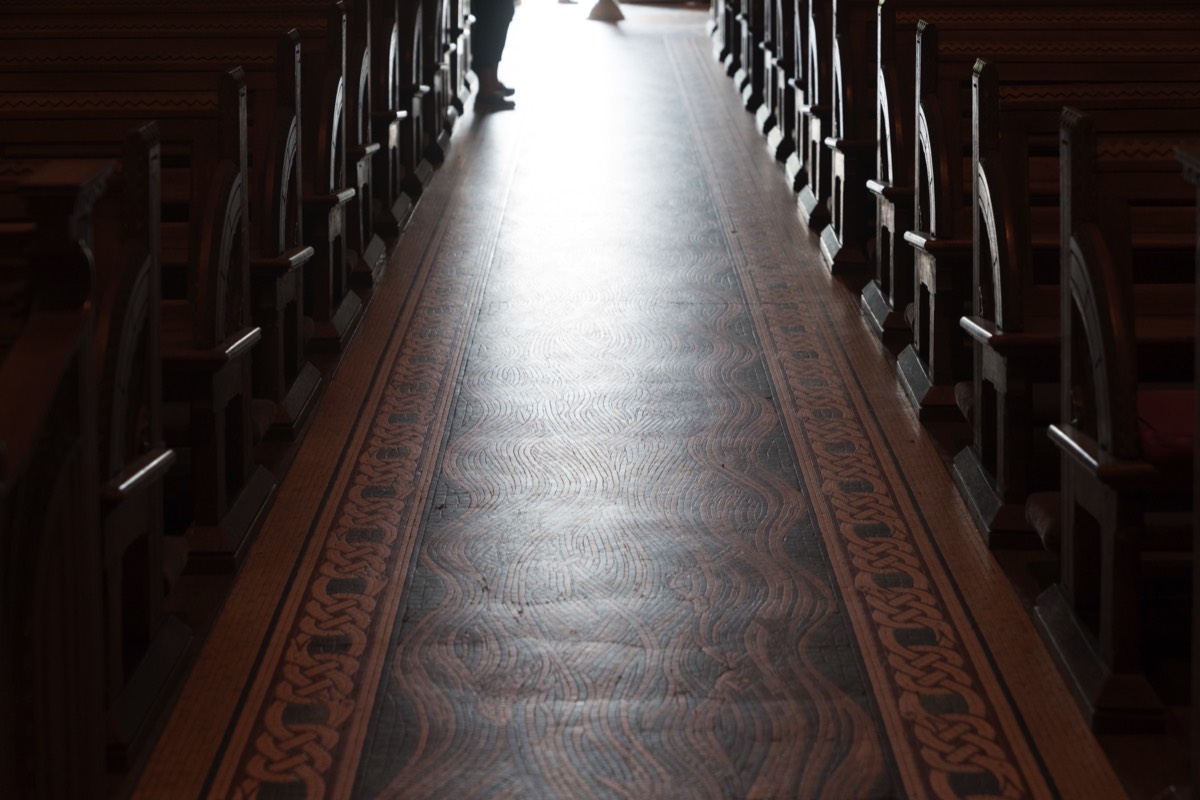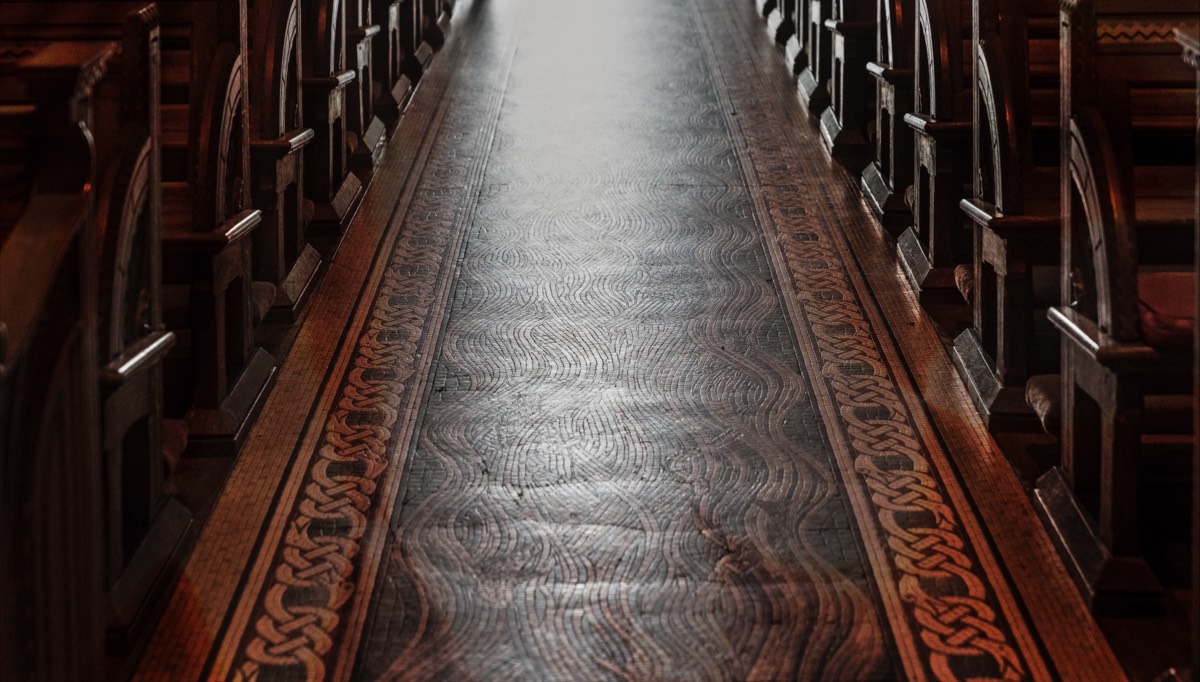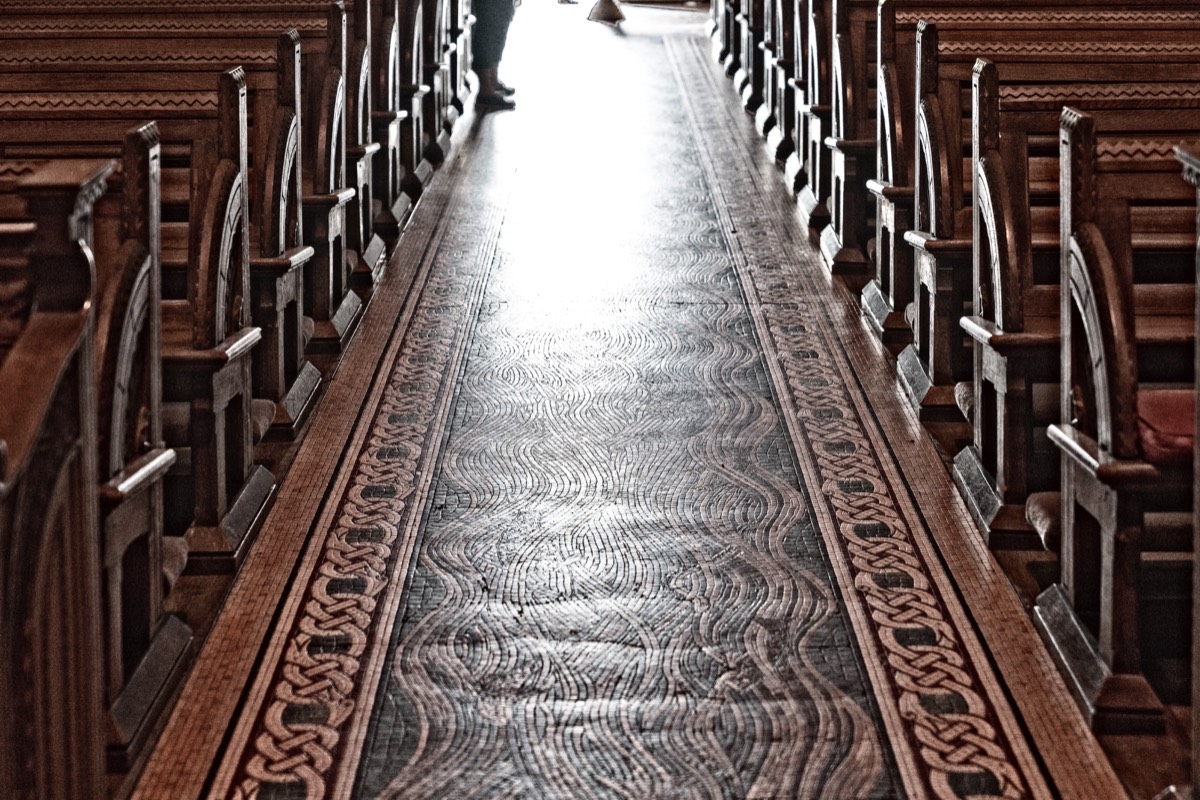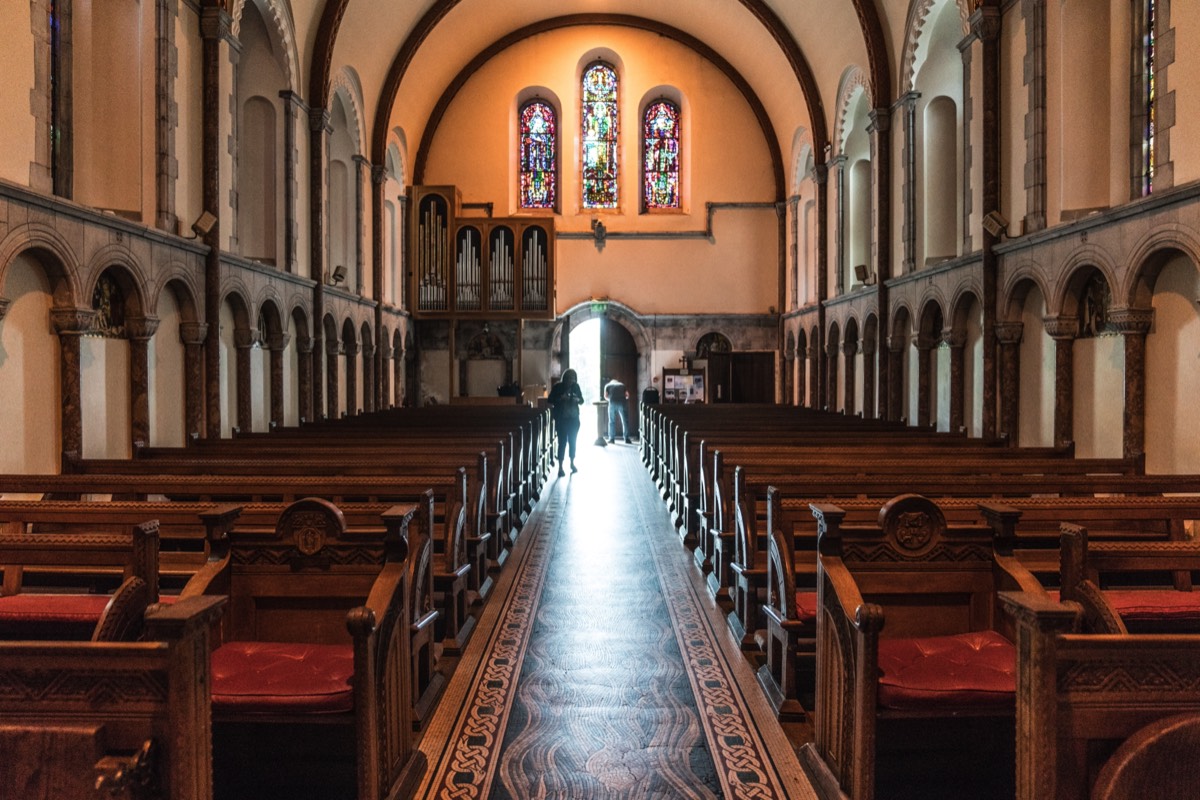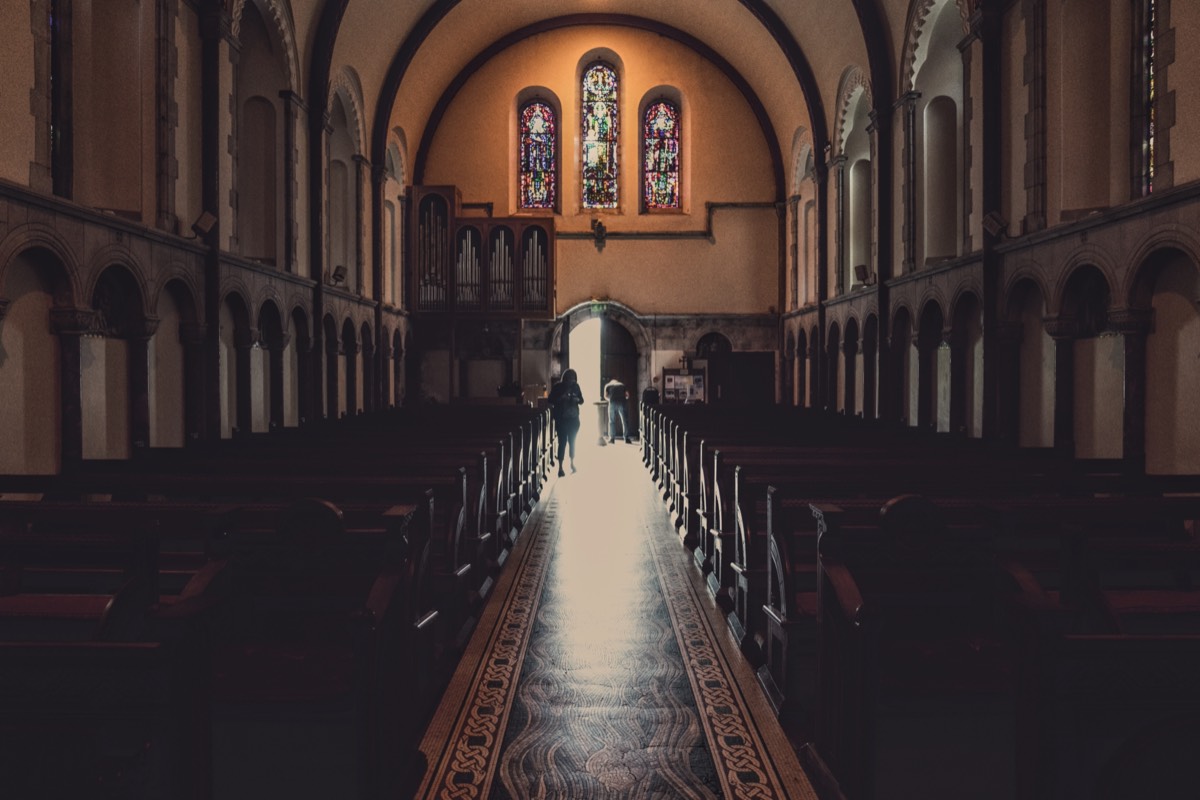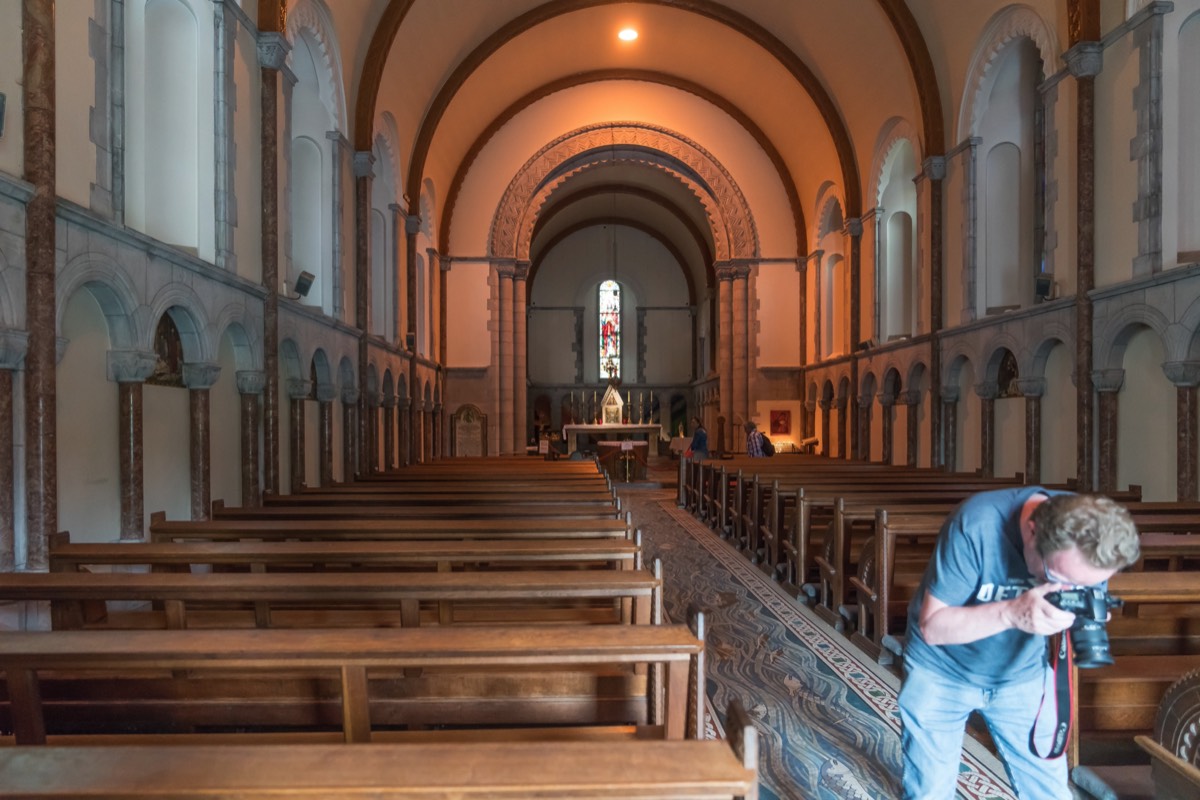HONAN CHAPEL
Without using a flash it was very difficult to photograph within this church because of the lack of suitable light.
The Honan Chapel, formally known as Saint Finbarr's Collegiate Chapel or the Honan Hostel Chapel is a small collegiate church located adjacent to the grounds of University College Cork in Cork city, Ireland.
The chapel, and its liturgical collection, was produced during the late phase of the Irish Arts and Crafts movement (1894–1925). Both the building and furnishings were designed and produced as a single commission. This accounts for an overall unity of style and design and the rich interplay of Celto-Byzantine motifs in the fabric of the building and the ornate furnishings, altar plate, hangings and vestments. The traditions of Celtic art and Hiberno-Romanesque architecture were blended with tastes for Symbolism (arts) and Art Nouveau popular in Europe before the outbreak of the First World War (1914–18). In Ireland this was known, artistically, as the Celtic Twilight: a time for rediscovering a lost national identity through Celtic art and myths. This is seen in the poetry of W. B. Yeats and the plays of J. M. Synge. Visually, the patrons of the Honan commission were searching for a new sense of Irish national identity on the threshold of political independence from Britain.
Since the opening of the Honan Chapel, in 1916, the colourful mosaic floor has attracted much interest due to the fine quality of its craftsmanship. Yet, the identity of the mosaic designer is unattributed in the chapel guidebook, written by John Robert O'Connell, published in 1916 and republished by Michael J. O'Kelly in 1966. Paul Larmour, Mary Leland and Virginia Teehan & Elizabeth Wincott Heckett attribute the design to the firm of Ludwig Oppenheimer in Manchester. In 2006, Michael Holland in Ireland and Robert Field in England independently proposed Lehmann James Oppenheimer (Field; Holland) and his son Eric Newton (Field) as the designers of the Honan Chapel mosaic floor and the Stations of the Cross.
On the outbreak of war both father and son joined the British army and saw action in France. Lehmann James Oppenheimer, who had joined the Artists' Rifles, died in hospital on 8 November 1916 following a gas attack in the heavily defended German lines of the Vimy sector, north of Arras, during the final phases of the Somme Offensive. His son, who survived the war, succeeded him as designer in the family firm until 1933. In 1936 he married Stella Mary Newton (née Pearce), costume designer and dress historian: born London 17 April 1901; appointed an OBE in 1976; died in London on 18 May 2001. Oppenheimer's established in 1865, finally closed in 1965.
Design highlights include the mosaic floor, with its focus on the Christian theme of the "River of Life", the tabernacle with enamels by Oswald Reeves and, most famously, the stained glass windows of Harry Clarke and Sarah Purser's studio. The St. Gobnait window on the north side of the chapel was nearly destroyed during the Easter Rising in Dublin. Changes in the liturgy, brought about by Vatican II, gave opportunities for a new generation of artists to decorate the Honan Chapel between 1983 and 2001. Imogen Stuart designed the altar, ambo, priest's chair and baptismal font. Hangings were designed by Evelyn Ross and Kim En Joong. The organ was built by Kenneth Jones, Bray, Co. Wicklow. Music plays a central part in the celebration of the liturgy in the chapel. Sunday liturgy is accompanied by a resident cantor and organist.
The chapel was consecrated on 5 November 1916. Although the chapel is dedicated to Cork's patron Finbarr, its name commemorates the chapel's benefactors, wealthy Cork merchants, the Honan family. When Isabella Honan died in 1913, the executor of her will, Rev. Sir John O´Connell, allocated £40,000 of the Honan estate to then Queen's College, now University College, Cork. Under the foundation charter of Queen's College Cork (1845) the college is non-denominational. As Catholic students had no place of worship, some of the money from the Honan estate was bequesthed to build a chapel and hostel (now demolished) to serve Roman Catholic students and staff of the University.
The foundation stone of the Honan Chapel was laid on 18 May 1915. The architectural style of the chapel cites the Hiberno-Romanesque tradition of the Middle Ages. The Chapel is most similar to the 12th-century church of St. Cronan in Roscrea, County Tipperary, while its bell-tower on the north wall is inspired by round towers of monastic settlements so common in Ireland from the 9th century onwards.
Built by John Sisk & Son, it illustrates the role played by the Dublin schools in helping to renew Cork craftsmanship in the first decades of the twentieth-century. Rev. Sir John Robert O’Connell, educated by the Jesuits at Belvedere College, Dublin, was a driving force in its construction. The Irish Jesuits educated a number of the leading patrons of the Irish Arts & Crafts movement. Thomas Bodkin had attended Belvedere College and Clongowes Wood. He became Director of the National Gallery, Dublin (1927–35). One of the movement's internationally best-known craftsmen, Harry Clarke, a stained glass artist and book illustrator, was educated at Belvedere College. O'Connell worked closely with the president of University College Cork, Sir Bertram Allan Coghill Windle (1858–1929), to achieve his goals. The chapel and its liturgical collection are products of the Irish Arts & Crafts Movement (1894–1925). This accounts for the overall unity of style. It was envisaged that the chapel would serve the needs of college students residing in the nearby Honan Hostel (1914–1991).
John Robert O’Connell commissioned the Cork firm of Egan & Sons for work on the altar plate and vestments. Craftswomen played a significant role in the Irish Arts & Crafts movement. The names of seamstresses from the Egan workshop, formerly in 32 Patrick St. Cork, are inscribed in the lining of the Cloth of Gold. These items are a testament to the significant role played by women in the Irish Arts & Crafts Movement. These fragile items are currently in storage and in need of conservation. Students from the Crawford Municipal Technical Institute, which became the Crawford College of Art & Design, were involved in the exterior carvings. The foundation stone of the chapel was laid on 18 May 1915. James Finbarre McMullen was the architect and John Sisk was the builder. Both were Cork firms. McMullen had a high profile in the city. He had been High Sheriff for the City of Cork in 1907-08. Significant works by McMullen in Cork city include: Eye, Ear & Throat Hospital, Western Rd. (1897); conservation of the Firkin Crane, built in 1855 in the Shandon district of the city (1900); St. Finbarre’s West Total Abstinence Club, Bandon Road. (1900), formerly known as "Lough Rovers" and now as the "Spires" apartment complex and the remodeling Holy Trinity Church, Fr. Mathew Quay (1906–08). In 1996 Sisk & Sons worked as contractors on the O'Rahilly Building project. This complex was built on the site of the former Honan Hostel (1914–91).
The Honan Chapel is internationally regarded as representing the best artwork of the Irish Arts & Crafts Movement (1894–1925). However, socially, the commission was also significant because the project generated much needed work in Cork during the First World War (1914–18). The project fostered the revival of silver and textile craft working, once central to the Cork economy, and supported local firms, through patronage, such as the builders John Sisk & Son. Today Sisk is a construction firm of national importance. Egan’s of Patrick Street continued making liturgical altar plate and textiles until it ceased trading in 1986. As a central figure behind the Honan commission, Rev. Sir John Robert O’Connell was a catalyst in Irish cultural life at the turn of the twentieth century. His collaboration with Sir Bertram Windle between 1914-17 greatly assisted the physical expansion of University College Cork and the revival of craft industry in Cork.
The Honan Chapel, formally known as Saint Finbarr's Collegiate Chapel or the Honan Hostel Chapel is a small collegiate church located adjacent to the grounds of University College Cork in Cork city, Ireland.
The chapel, and its liturgical collection, was produced during the late phase of the Irish Arts and Crafts movement (1894–1925). Both the building and furnishings were designed and produced as a single commission. This accounts for an overall unity of style and design and the rich interplay of Celto-Byzantine motifs in the fabric of the building and the ornate furnishings, altar plate, hangings and vestments. The traditions of Celtic art and Hiberno-Romanesque architecture were blended with tastes for Symbolism (arts) and Art Nouveau popular in Europe before the outbreak of the First World War (1914–18). In Ireland this was known, artistically, as the Celtic Twilight: a time for rediscovering a lost national identity through Celtic art and myths. This is seen in the poetry of W. B. Yeats and the plays of J. M. Synge. Visually, the patrons of the Honan commission were searching for a new sense of Irish national identity on the threshold of political independence from Britain.
Since the opening of the Honan Chapel, in 1916, the colourful mosaic floor has attracted much interest due to the fine quality of its craftsmanship. Yet, the identity of the mosaic designer is unattributed in the chapel guidebook, written by John Robert O'Connell, published in 1916 and republished by Michael J. O'Kelly in 1966. Paul Larmour, Mary Leland and Virginia Teehan & Elizabeth Wincott Heckett attribute the design to the firm of Ludwig Oppenheimer in Manchester. In 2006, Michael Holland in Ireland and Robert Field in England independently proposed Lehmann James Oppenheimer (Field; Holland) and his son Eric Newton (Field) as the designers of the Honan Chapel mosaic floor and the Stations of the Cross.
On the outbreak of war both father and son joined the British army and saw action in France. Lehmann James Oppenheimer, who had joined the Artists' Rifles, died in hospital on 8 November 1916 following a gas attack in the heavily defended German lines of the Vimy sector, north of Arras, during the final phases of the Somme Offensive. His son, who survived the war, succeeded him as designer in the family firm until 1933. In 1936 he married Stella Mary Newton (née Pearce), costume designer and dress historian: born London 17 April 1901; appointed an OBE in 1976; died in London on 18 May 2001. Oppenheimer's established in 1865, finally closed in 1965.
Design highlights include the mosaic floor, with its focus on the Christian theme of the "River of Life", the tabernacle with enamels by Oswald Reeves and, most famously, the stained glass windows of Harry Clarke and Sarah Purser's studio. The St. Gobnait window on the north side of the chapel was nearly destroyed during the Easter Rising in Dublin. Changes in the liturgy, brought about by Vatican II, gave opportunities for a new generation of artists to decorate the Honan Chapel between 1983 and 2001. Imogen Stuart designed the altar, ambo, priest's chair and baptismal font. Hangings were designed by Evelyn Ross and Kim En Joong. The organ was built by Kenneth Jones, Bray, Co. Wicklow. Music plays a central part in the celebration of the liturgy in the chapel. Sunday liturgy is accompanied by a resident cantor and organist.
The chapel was consecrated on 5 November 1916. Although the chapel is dedicated to Cork's patron Finbarr, its name commemorates the chapel's benefactors, wealthy Cork merchants, the Honan family. When Isabella Honan died in 1913, the executor of her will, Rev. Sir John O´Connell, allocated £40,000 of the Honan estate to then Queen's College, now University College, Cork. Under the foundation charter of Queen's College Cork (1845) the college is non-denominational. As Catholic students had no place of worship, some of the money from the Honan estate was bequesthed to build a chapel and hostel (now demolished) to serve Roman Catholic students and staff of the University.
The foundation stone of the Honan Chapel was laid on 18 May 1915. The architectural style of the chapel cites the Hiberno-Romanesque tradition of the Middle Ages. The Chapel is most similar to the 12th-century church of St. Cronan in Roscrea, County Tipperary, while its bell-tower on the north wall is inspired by round towers of monastic settlements so common in Ireland from the 9th century onwards.
Built by John Sisk & Son, it illustrates the role played by the Dublin schools in helping to renew Cork craftsmanship in the first decades of the twentieth-century. Rev. Sir John Robert O’Connell, educated by the Jesuits at Belvedere College, Dublin, was a driving force in its construction. The Irish Jesuits educated a number of the leading patrons of the Irish Arts & Crafts movement. Thomas Bodkin had attended Belvedere College and Clongowes Wood. He became Director of the National Gallery, Dublin (1927–35). One of the movement's internationally best-known craftsmen, Harry Clarke, a stained glass artist and book illustrator, was educated at Belvedere College. O'Connell worked closely with the president of University College Cork, Sir Bertram Allan Coghill Windle (1858–1929), to achieve his goals. The chapel and its liturgical collection are products of the Irish Arts & Crafts Movement (1894–1925). This accounts for the overall unity of style. It was envisaged that the chapel would serve the needs of college students residing in the nearby Honan Hostel (1914–1991).
John Robert O’Connell commissioned the Cork firm of Egan & Sons for work on the altar plate and vestments. Craftswomen played a significant role in the Irish Arts & Crafts movement. The names of seamstresses from the Egan workshop, formerly in 32 Patrick St. Cork, are inscribed in the lining of the Cloth of Gold. These items are a testament to the significant role played by women in the Irish Arts & Crafts Movement. These fragile items are currently in storage and in need of conservation. Students from the Crawford Municipal Technical Institute, which became the Crawford College of Art & Design, were involved in the exterior carvings. The foundation stone of the chapel was laid on 18 May 1915. James Finbarre McMullen was the architect and John Sisk was the builder. Both were Cork firms. McMullen had a high profile in the city. He had been High Sheriff for the City of Cork in 1907-08. Significant works by McMullen in Cork city include: Eye, Ear & Throat Hospital, Western Rd. (1897); conservation of the Firkin Crane, built in 1855 in the Shandon district of the city (1900); St. Finbarre’s West Total Abstinence Club, Bandon Road. (1900), formerly known as "Lough Rovers" and now as the "Spires" apartment complex and the remodeling Holy Trinity Church, Fr. Mathew Quay (1906–08). In 1996 Sisk & Sons worked as contractors on the O'Rahilly Building project. This complex was built on the site of the former Honan Hostel (1914–91).
The Honan Chapel is internationally regarded as representing the best artwork of the Irish Arts & Crafts Movement (1894–1925). However, socially, the commission was also significant because the project generated much needed work in Cork during the First World War (1914–18). The project fostered the revival of silver and textile craft working, once central to the Cork economy, and supported local firms, through patronage, such as the builders John Sisk & Son. Today Sisk is a construction firm of national importance. Egan’s of Patrick Street continued making liturgical altar plate and textiles until it ceased trading in 1986. As a central figure behind the Honan commission, Rev. Sir John Robert O’Connell was a catalyst in Irish cultural life at the turn of the twentieth century. His collaboration with Sir Bertram Windle between 1914-17 greatly assisted the physical expansion of University College Cork and the revival of craft industry in Cork.
SORRY FOR THE DELAY
THE PHOTO DIARY IS NOT LIMITED TO CORK AS I ONLY VISIT THE CITY ONCE EVERY YEAR AND 2020 MAY BE AN EXCEPTION. I AM BASED IN DUBLIN BUT DURING THE SUMMER MONTHS I VISIT BELFAST, LIMERICK, GALWAY, KILKENNY AND WATERFORD AND USUALLY DEVOTE A WEEK TO PHOTOGRAPHING EACH OF THE CITIES IN QUESTION
You will find links to buy products from Amazon, Google and other partners. If you click on these links, you’ll find that the URL includes a small extra piece of text which identifies that the click came from my websites. This text is an affiliate code, and it means that I get a small percentage of the money you spend if you choose to buy that product, or, in some cases, other products from the site soon after. These affiliate links help pay the costs of producing my websites and ensure that the content is free to you.
